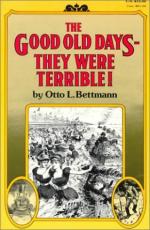
|
| Name: _________________________ | Period: ___________________ |
This test consists of 5 multiple choice questions, 5 short answer questions, and 10 short essay questions.
Multiple Choice Questions
1. According to Bettmann in "Housing," where did poorer residents end up who could not afford tenements?
(a) Boarding homes.
(b) Sleeping at railway stations.
(c) On the outskirts of the city.
(d) Homeless shelters.
2. How were on-the-job accidents dealt with in the late 1800s?
(a) With a letter of apology.
(b) They were ignored.
(c) Workers were treated on site.
(d) With pay compensation.
3. In what year was the El Train introduced?
(a) 1868.
(b) 1870.
(c) 1898.
(d) 1902.
4. According to the chapter "Work," what was a typical work week in the late 1800s?
(a) Six days.
(b) Four days on, four days off.
(c) Seven days.
(d) Five days.
5. In the late 1800s, who was it that posed a threat to those on the frontier and instilled a sense of fear?
(a) Train robbers.
(b) Cattle thieves.
(c) Runaways.
(d) Tramps and various vagrants.
Short Answer Questions
1. Why did tenants in the late 1800s have such big problems when it came to housing in the big cities?
2. In the late 19th century on the frontier, what was a child's formal education considered to be?
3. What was the name of the first vertical apartments?
4. Why were some animals a pollutant problem as noted in the chapter "Air"?
5. In the time after the Civil War, humans generated an amazing amount of:
Short Essay Questions
1. According to the chapter "Air," what were some of the problems with using a streetcar for transportation?
2. What was the most famous sewing-related sweatshop in New York?
3. What were some of the back-breaking laborious chores that frontier women had to endure?
4. Why was child labor so common in the late 1800s?
5. What caused the local wells on the frontier to become contaminated?
6. What was the area in New York that was the worst air pollution offender in the late 19th century?
7. How did landlords take unfair advantage of their tenants in the late 19th century?
8. How did railroads contribute to the pollution and danger for many cities?
9. How did the electric trolley car, which was built to improve the traffic situation, actually make the traffic problem worse?
10. How does author Otto Bettman attempt to shatter the misconception of this era, and what is the result?
|
This section contains 736 words (approx. 3 pages at 300 words per page) |

|




